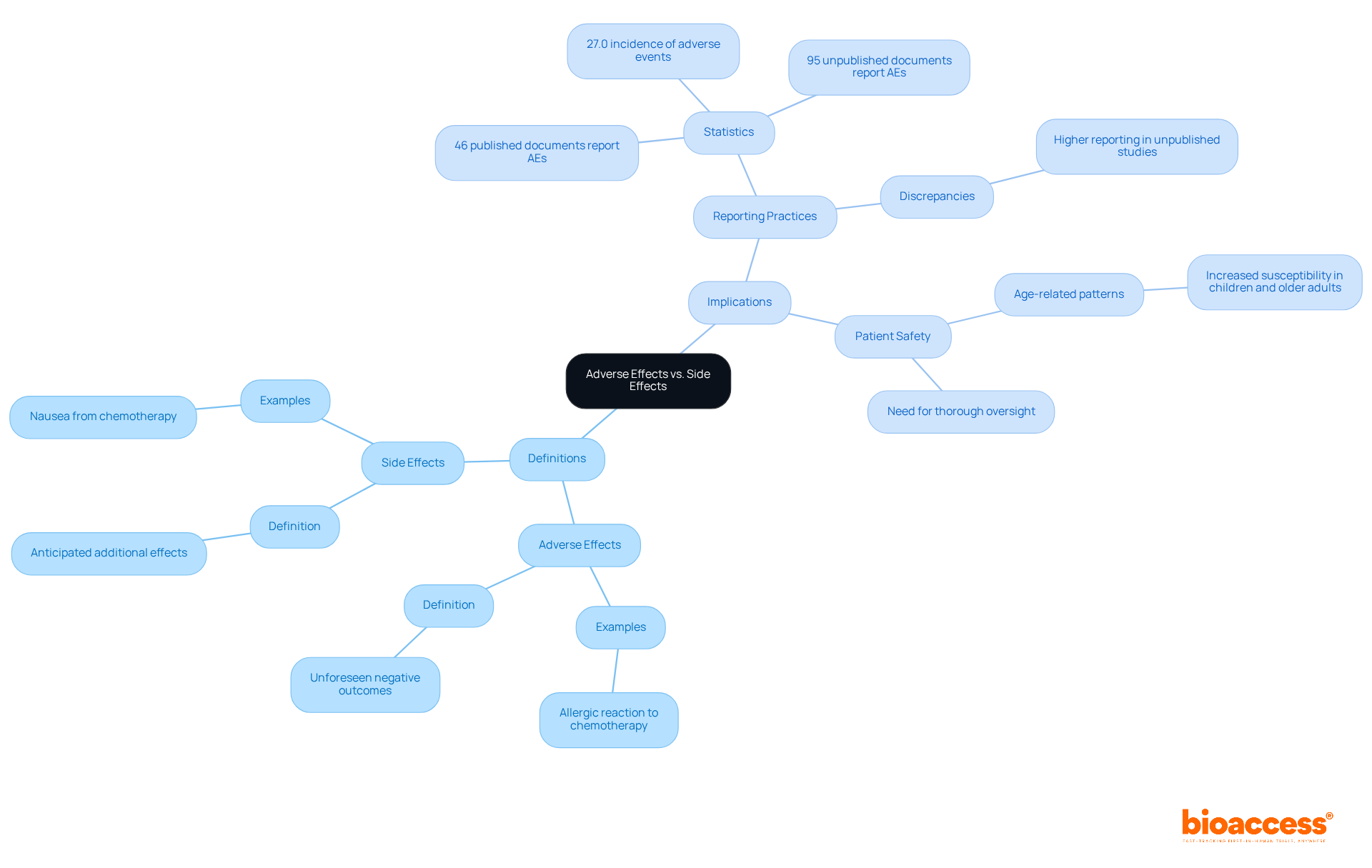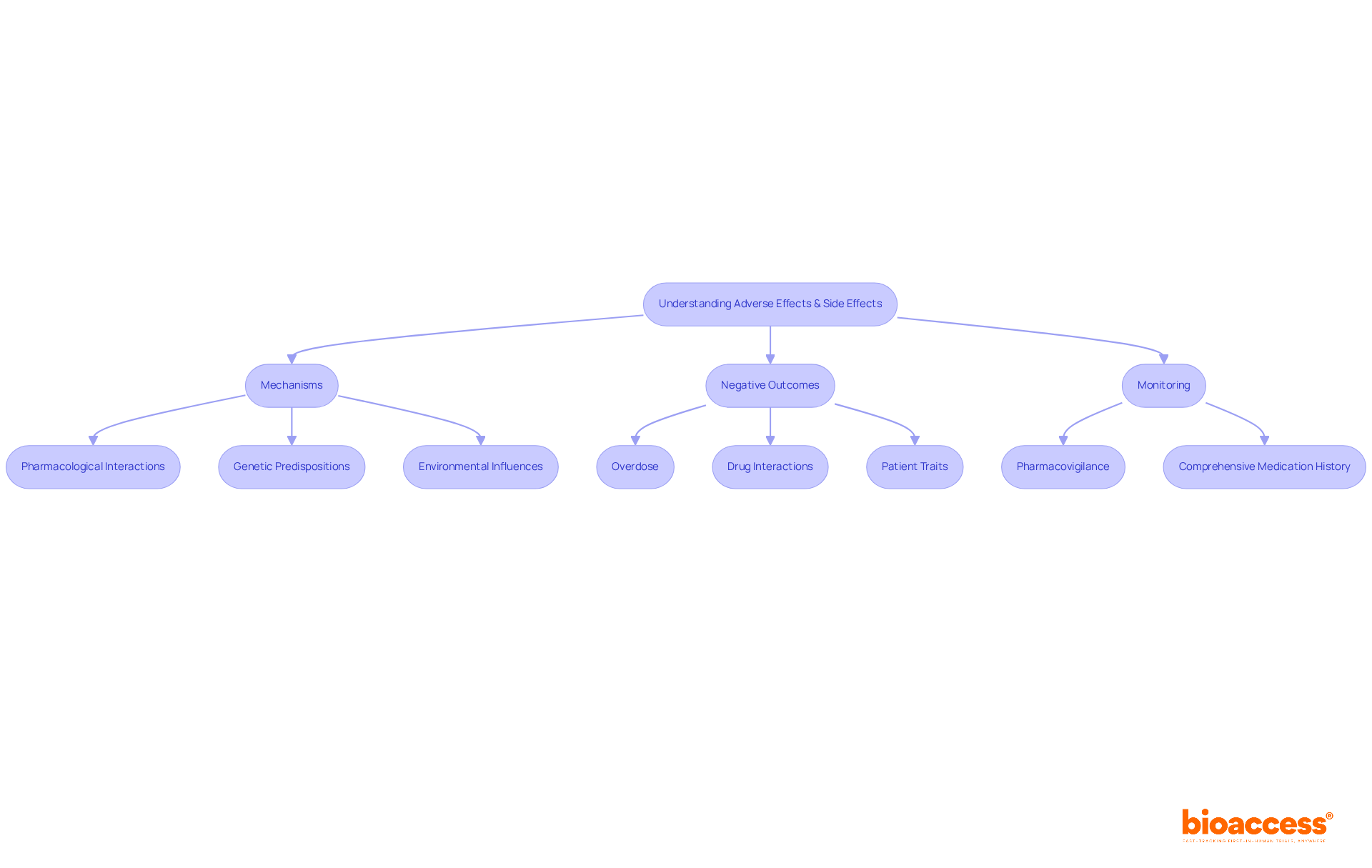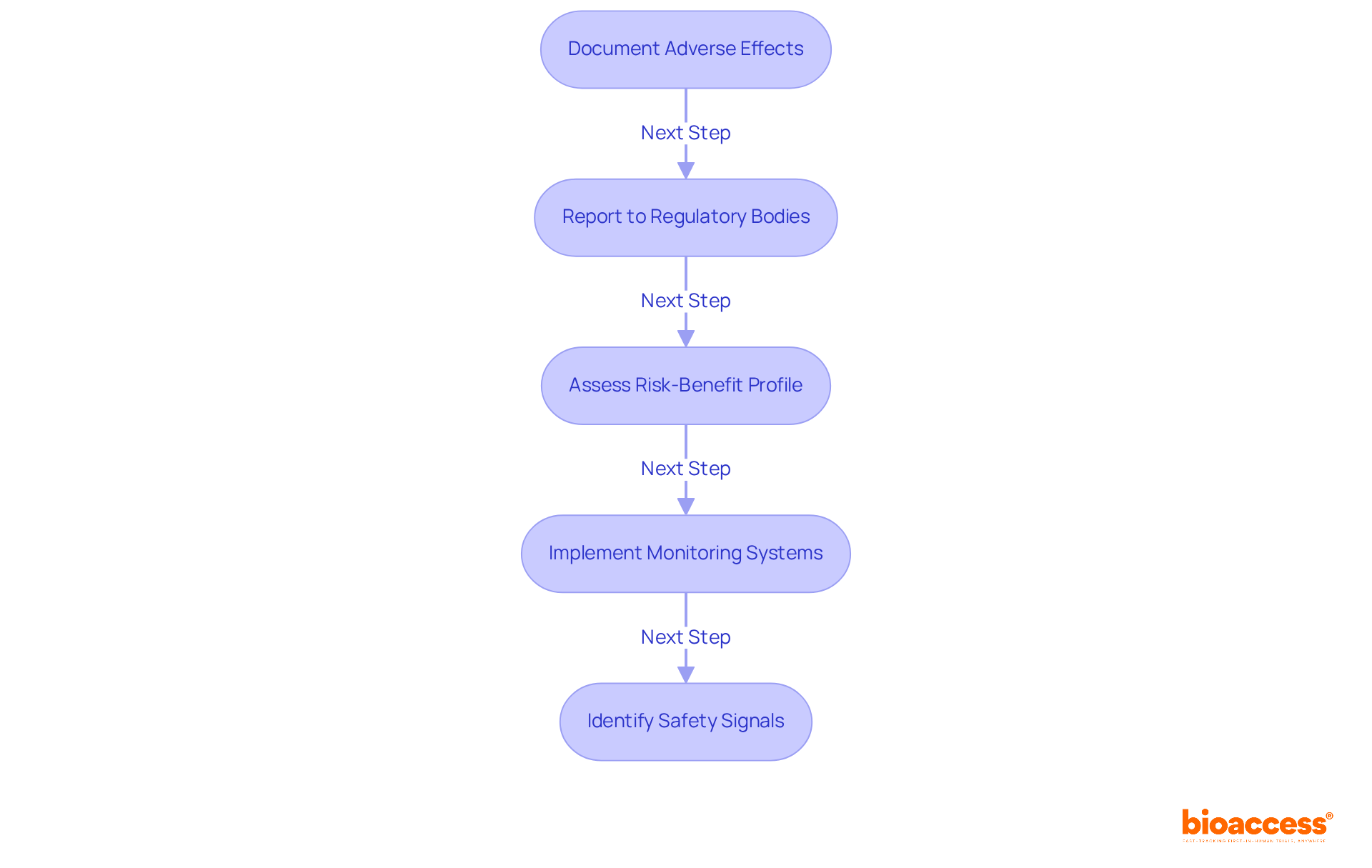


The article emphasizes the critical distinctions between adverse effects and side effects in clinical trials, underscoring the necessity of understanding and documenting these differences for patient safety and regulatory compliance. It articulates that side effects are often anticipated and can even be beneficial, whereas adverse effects are unforeseen and potentially harmful. This highlights the imperative for rigorous monitoring and reporting practices in clinical research, ensuring that all stakeholders are equipped to navigate these complexities effectively.
Understanding the nuances between adverse effects and side effects is crucial in the realm of clinical trials, where patient safety and treatment efficacy are paramount. Medical interventions can lead to a spectrum of reactions, ranging from mild discomfort to severe complications. Grasping this distinction not only enhances patient care but also informs regulatory practices.
However, with a staggering percentage of negative incidents often underreported, one must ponder: how can researchers ensure comprehensive monitoring and documentation to safeguard participants and uphold the integrity of clinical research?
Negative outcomes highlight the adverse effects and side effects difference that can arise from medical interventions, such as drugs or treatments. These impacts can vary significantly in intensity, ranging from mild discomfort to life-threatening conditions, often necessitating further medical intervention. Conversely, the adverse effects and side effects difference indicates that side reactions are additional effects that may occur alongside the intended therapeutic outcomes of a treatment. While side reactions can be anticipated and, at times, beneficial, the adverse effects and side effects difference typically shows that negative outcomes are unforeseen and detrimental. For instance, nausea resulting from chemotherapy is classified as a side effect, while an allergic reaction to the same chemotherapy agent illustrates the adverse effects and side effects difference.
Recent research indicates that the incidence of negative incidents in medical studies may be as high as 27.0%, underscoring the critical need for thorough oversight and documentation. Furthermore, the median percentage of published documents reporting negative events was 46%, in stark contrast to 95% for unpublished documents, highlighting significant discrepancies in reporting practices. Understanding the adverse effects and side effects difference is essential for ensuring the safety and efficacy of clinical trials, as it directly informs both patient care and regulatory practices.
Real-world examples further illustrate this issue: in clinical settings, patients may experience side effects such as fatigue or mild gastrointestinal discomfort, while serious negative effects, including anaphylaxis or severe organ damage, can result in significant complications and demand immediate medical attention. Additionally, age-related patterns of adverse events have been observed, with both children and older adults exhibiting heightened susceptibility. This nuanced understanding is imperative for healthcare professionals engaged in clinical research and patient safety.

Numerous mechanisms, such as pharmacological interactions, genetic predispositions, and environmental influences, can lead to negative consequences and secondary reactions, which illustrate the adverse effects and side effects difference. Understanding pharmacodynamics and pharmacokinetics is critical in determining how drugs interact within the body. Negative outcomes may occur due to elements like overdose, drug interactions, or individual patient traits, including age, gender, and pre-existing health issues, which illustrate the adverse effects and side effects difference.
For instance, between 5% and 10% of patients may experience an adverse drug reaction (ADR) upon admission or during treatment, which highlights the adverse effects and side effects difference and underscores the importance of closely monitoring these interactions. Alarmingly, it is estimated that fewer than 5% of all ADRs are reported in practice, emphasizing the need for vigilant pharmacovigilance. The UK Yellow Card Scheme, which receives approximately 25,000 reports of suspected ADRs annually, illustrates the scale of ADR reporting and its relevance to drug safety.
Moreover, understanding the adverse effects and side effects difference is crucial, as adverse reactions frequently arise from the drug's intended pharmacological action; for example, drowsiness is a common reaction of antihistamines. Comprehending these mechanisms is crucial for anticipating and managing possible reactions during research trials, as genetic predispositions also play a significant role. Research indicates that certain genetic factors can increase susceptibility to specific side effects, highlighting the adverse effects and side effects difference, which complicates the assessment of drug safety and efficacy.
Furthermore, studies indicate that between one-third and one-half of ADRs could be avoidable, highlighting the significance of proactive measures in medical research. By acknowledging these interactions and tendencies, medical researchers can more effectively foresee negative incidents and enhance patient safety during the study process. Additionally, maintaining a comprehensive medication history is vital for identifying ADRs and ensuring effective monitoring.

The acknowledgment and documentation of the adverse effects and side effects difference are critical components of clinical research protocols. Regulatory bodies, including the FDA, mandate that all adverse events be meticulously documented and reported to safeguard participant safety and to clarify the adverse effects and side effects difference while assessing the risk-benefit profile of investigational products.
bioaccess provides a comprehensive process for enhancing medical device evaluations, encompassing feasibility studies, site selection, and compliance reviews—elements that are vital for effective monitoring. Neglecting to report these events can lead to severe consequences, including the adverse effects and side effects difference, which may result in participant harm and legal ramifications for the sponsoring organization.
Moreover, timely reporting facilitates the identification of potential safety signals that may reveal the adverse effects and side effects difference, which could necessitate modifications in study protocols or product labeling. Researchers must implement robust systems for monitoring and reporting these occurrences throughout the testing process.
bioaccess's project management and reporting services are specifically designed to support these essential activities.

Successfully evaluating and handling the adverse effects and side effects difference in research studies is crucial for ensuring participant safety and maintaining the integrity of clinical research. This endeavor requires an organized method that emphasizes oversight, record-keeping, and prompt action. Research trial groups, supported by comprehensive trial management services like feasibility studies, site selection, compliance evaluations, and reporting provided by bioaccess, must conduct regular evaluations of participants to swiftly identify any adverse effects and side effects difference. Such evaluations can be effectively carried out through patient interviews, standardized questionnaires, and thorough clinical assessments.
Upon recognizing a negative consequence, it is essential to document it meticulously, detailing its nature, severity, and any follow-up actions taken. Management strategies may involve dose adjustments, supportive care, or, in certain instances, discontinuation of the treatment, considering the adverse effects and side effects difference. By informing participants about the adverse effects and side effects difference and encouraging them to report any unusual symptoms, the study enhances safety and adherence. Establishing clear protocols for managing these occurrences is vital for upholding the study's integrity and ensuring that participants are aware of the adverse effects and side effects difference.
Moreover, consistent monitoring and adherence to these protocols not only safeguard participant health but also provide insights into the adverse effects and side effects difference, ultimately bolstering the credibility of study results and advancing medical knowledge. Research studies play an essential role in preventing unsafe therapies from entering the market, as evidenced by the success of COVID-19 vaccine studies, which have saved millions of lives. Drawing on insights from seasoned clinical trial managers, such as Oswaldo Amaya, MD, and Juan Cuya, MD, can further optimize these management strategies, ensuring that the adverse effects and side effects difference is addressed appropriately.

Understanding the distinction between adverse effects and side effects is vital in clinical trials, as it directly impacts patient safety and the overall integrity of medical research. While side effects can be anticipated and sometimes beneficial, adverse effects represent unforeseen and harmful reactions that require immediate attention. Recognizing this difference is essential for healthcare professionals, researchers, and regulatory bodies alike, as it informs their approach to patient care and the evaluation of therapeutic interventions.
The article highlights key arguments surrounding the importance of thorough documentation and reporting of both adverse effects and side effects in clinical trials. It underscores the significant prevalence of negative incidents, the mechanisms behind these reactions, and the critical role of regulatory compliance in safeguarding participant safety. By emphasizing the need for vigilant monitoring and proactive management strategies, the article illustrates how understanding these differences can lead to better patient outcomes and enhance the credibility of clinical research.
Ultimately, the insights provided serve as a call to action for all stakeholders involved in clinical trials. By prioritizing the recognition and reporting of adverse effects and side effects, researchers can not only protect participants but also contribute to the advancement of medical knowledge and the development of safer therapies. Embracing best practices in managing these reactions is essential in fostering a culture of safety and accountability in clinical research, ensuring that the benefits of medical innovations can be realized without compromising patient health.
What is the difference between adverse effects and side effects?
Adverse effects refer to negative outcomes from medical interventions that are often unforeseen and detrimental, while side effects are additional effects that may occur alongside the intended therapeutic outcomes, which can sometimes be anticipated and beneficial.
Can you provide examples of side effects and adverse effects?
An example of a side effect is nausea resulting from chemotherapy, whereas an allergic reaction to the same chemotherapy agent is an example of an adverse effect.
What is the incidence of negative incidents in medical studies?
Recent research indicates that the incidence of negative incidents in medical studies may be as high as 27.0%.
How do reporting practices differ between published and unpublished documents regarding negative events?
The median percentage of published documents reporting negative events was 46%, compared to 95% for unpublished documents, highlighting significant discrepancies in reporting practices.
Why is understanding the difference between adverse effects and side effects important?
Understanding this difference is essential for ensuring the safety and efficacy of clinical trials, as it directly informs patient care and regulatory practices.
What types of negative effects might patients experience in clinical settings?
Patients may experience side effects such as fatigue or mild gastrointestinal discomfort, while serious negative effects can include anaphylaxis or severe organ damage, which require immediate medical attention.
Are certain populations more susceptible to adverse events?
Yes, both children and older adults have been observed to exhibit heightened susceptibility to adverse events.